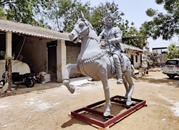

Weekly Current Affairs: Week 4 - June 2022 (36 Topics)
Context
A bronze statue of Kedambady Ramayya Gowda, who revolted against the British in a mass insurrection in 1837, will be brought to Dakshina Kannada, Mangaluru, Karnataka.
About
About Kedambady Ramayya Gowda’s:
- Kedambady Ramayya Gowda is said to have revolted against the British in a mass insurrection in 1837.
- He led the Amara Sullia uprising.
- Gowda, opposing payment of tax in cash to the British, had set out from Ubaradka Mithoor in Sullia taluk on March 30, 1837.
- En route, he had motivated many rulers to join his rebellion against the British.
- Gowda’s army succeeded in defeating the British army and had lowered the British flag before hoisting the Kodagu Haleri dynasty’s flag in Bavutagudda on April 5, 1837.
- After the 13th day of hoisting the flag, the rebellion was crushed by the British army.
About the revolt:
- The ‘Amara Sullia Dange’ or Kodagu- Canara Mutiny took place twenty years before the First War of Independence in 1857.
- The revolt was against the high land revenue (tax) assessment and the absence of a lucrative market for farm produce.
- The revolt broke out against the East India Company in the coastal belt during 1830-31.
- It reached the stage of an armed struggle in 1837.
- The revolt was against the high land revenue (tax) assessment and the absence of a lucrative market for farm produce.
Outcomes:
- The revolutionaries lowered the British flag at Bavutagudda, now in the heart of Mangaluru, on April 5, 1837, and hoisted their own flag.
- The British were defeated. Those who survived retreated to Mangalore (presently known as Mangaluru).
- Some leaders captured by the British soldiers were later hanged, a few were put under life imprisonment, and some were deported.


